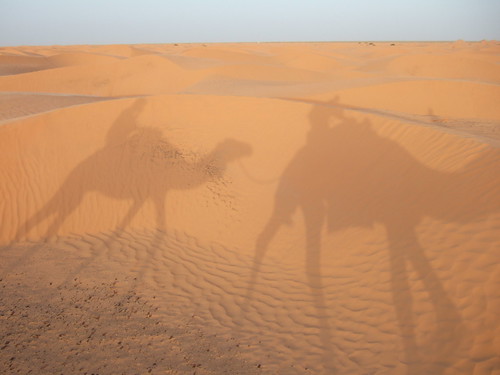Chott el-Jerid to Douz to Ksar Ghilane
After pricing three companies while in Tozeur, we settled with Au Coeur du Desert which charged us 350 dinars for a two-day tour. Our English-speaking guide, Taha, and his brother, Emin, picked us up as soon as we returned our car to Europcar, the rental agency. Taha drove like a maniac, but he was very charismatic. His heavily-accented English was easy enough to understand, but we couldn’t help but think of “sexy-time” every time he talked. He also looked like the restaurateur in The Sopranos, only happier and less desperate. He knew our itinerary well and he talked whenever he had something to show us along the way. The rest of the time, he and Emin spoke and laughed to each other in Arabic while we listened to how animated their conversations were.
Our first stop was Chott el-Jerid, the salt lake where Luke Skywalker contemplated the two moons in the first Star Wars movie. (I am probably the least knowledgeable person concerning Star Wars, but I feel I must add that point so that my friends will be able to relate. When I started telling them that I was going to Tunisia, their response always had something to do with the movie.) We stopped at where the locals have left a boat, a fake camel and a “4-star hotel” straw tent. The lake measures at least 5,000 square kilometers. It stretches to emptiness as the salt shimmers in the heat. Around us were pools of saltwater in red and yellow colors.
About two hours later, and after a brief stop to take photos of some sandstone pyramids along the way, we arrived in Douz. There were restaurants opened for tourists who weren’t participating in Ramadan, but we didn’t want to eat fried chicken nor spaghetti. We separated from Taha and Emin to hide and eat our usual bread-and-canned-fish lunch. Our throats were parched, so we could only imagine how thirsty they were. Even without water for hours, though, they still entertained us until we reached Ksar Ghilane.
We arrived at Campement el Biben in the middle of a very hot afternoon. We were shown where we were to sleep for the night: Bedouin tents. Bedouins are tribes who travel the desert, but today the term is used to refer even to non-Arabs who live simple, nomadic lives. Their tents are made of thick canvas, which almost feels like wool, and are meant to withstand all sorts of weather when used in the desert. Although we had the tent set-up, we were still spoiled by the beds inside and the bathroom with running water at the other side of the camp.
We spent the rest of the day lazing like dogs and swatting off flies, as we tried to sleep or read. It was hotter than being inside an oven. When it was almost sunset, we were rescued by Taha to introduce us to our camels. We knew that the guides had to be home by sundown to finish the day’s fast, so we only signed up for an hour ride around the dunes. Ksar Ghilane is surrounded by the dunes of the Great Eastern Erg, the most alluring desert scenery in Tunisia.
It was our first time on camels. It was a thrill to get on one and hold on while the camel took three steps to stand up. At first, the camel will make you lean back to get its footing on the sand, and then all of a sudden, it will lean forward to position itself to get up. And then, when you think you’re already set, it will lunge forward to actually stand up. I later learned that all camels in Tunisia have only one hump, or the Dromedary type, and that two-humped camels, also known as Bactrians, only exist in the deserts of China and Mongolia.
The novelty of riding a camel actually runs its course after about fifteen minutes. I can’t imagine how those who choose to ride it for days feel. But the scenery of the dunes was exhilarating. The sand is seriously a red-orange color, marked with waves and swirls left by the soft desert breeze. We let our guide and his camels go home and we finished watching the sun set behind the dunes. There was nothing to do, really, but enjoy the moment.
As the clock hit 7:32pm, Taha and Emin reached for their bottles and guzzled water. We all laughed out loud as Taha pointed to the clock and told us he was now free to eat and drink. But, of course, being Tunisian, they still offered us half of the freshly-baked damper bread they received from one of the locals when they ended the day’s fast. This kind of bread is cooked in the ashes of a camp fire in the desert. It’s more dense than the typical bread we’ve been buying in town bakeries, and also taste so much better.
For dinner, the camp’s staff served a plateful of spaghetti and fried chicken under the stars. For extra 4 dinars, we also had our first drink of the local beer. (We had been craving any type of liquor for the past five days, but they were very difficult to come by unless we walked in the nicer hotels and restaurants.) We were thankful that even a Muslim country like Tunisia makes its own beer. After eating, we sat outside our tents and watched the stars. Before the lights were turned off, we entered our tent and looked forward to sleeping a very peaceful nomad-style sleep.
Related post/s:
Day 5 in Tunisia: Chott el-Jerid photos on Flickr
Day 5 in Tunisia: Ksar Ghilane photos on Flickr
Day 4: Le Kef to Tozeur via Gafsa, Tunisia






